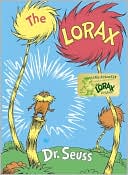 talking animals (see my earlier movie reviews). The movie expands on the book, The Lorax, by Dr. Seuss. Since the book is relatively short, the movie makers added a future to the story – we find out who received the truffula seed, why he received it, and what he did with it. The movie’s got it all, environmental message, budding romance, and the obligatory chase scene. It’s even got a few musical numbers! I would’ve liked to hear a bit more of Seuss’ poetry in the movie, but all in all, I liked this flick.
talking animals (see my earlier movie reviews). The movie expands on the book, The Lorax, by Dr. Seuss. Since the book is relatively short, the movie makers added a future to the story – we find out who received the truffula seed, why he received it, and what he did with it. The movie’s got it all, environmental message, budding romance, and the obligatory chase scene. It’s even got a few musical numbers! I would’ve liked to hear a bit more of Seuss’ poetry in the movie, but all in all, I liked this flick. As I was watching The Lorax, the old phrase “reduce, reuse, recycle” came to mind. At one point, one of the characters, the Once-ler, did a musical number about his invention, the Thneed. Totally forgetting the “reduce, reuse, recycle” ethos, the Once-ler produces thousands of Thneeds. What’s a Thneed? According to the original book, “A Thneed’s a Fine-Something-That-All-People-Need! It’s a shirt. It’s a sock. It’s a glove. It’s a hat. But it has other uses. Yes, far beyond that. You can use it for carpets. For pillows! For sheets! Or curtains! Or covers for bicycles seats!” Yes, the Once-ler was convinced that he was making something that people needed and wanted. And the movie shows thousands of people clamoring for this invention, convinced that they needed it.
But then my son made an interesting observation. He noticed that no one was wearing or using a Thneed later in the movie. Obviously, this thing that everyone HAD to have, wasn’t really so necessary. This one little point from the movie got me thinking about all the things that we HAVE to have; all of the things we use precious natural resources to produce that end up in a closet, garage, or landfill somewhere. How many times have we replaced a phone, to get a newer, smarter one? How many times have we thrown away food that rotted before we got around to eating it? Got the latest exercise equipment gathering dust in your basement? What about taking an unnecessary bag at the store? Ever grabbed too many mustard packets at a restaurant (to avoid having to get up and get more), and then thrown them away at the end of the meal? It’s the “reduce” portion of the pollution prevention puzzle that’s the most important, but also seems to be the most difficult to achieve. Take a quick look at many of the “environmental” websites and blogs out there – how many are simply selling “green” products? Rather than reducing the constant consumption that affects our environment, we fool ourselves into thinking that “green” consumption is somehow innocuous. It may be better than other consumption, but even “green” consumption is consumption.
So should we simply stop buying stuff? I think we all know that’s not an option for most of us. We all need food, clothing, housing, and some of the fun stuff too (I personally enjoy printing my photographs and wearing decent running shoes). What we need to do is become more conscious of our decisions, trying to focus heavily on the “reduce” part of pollution prevention. When you do want to make a purchase, think twice. You’re not just deciding whether you can afford it, but deciding whether the planet can afford it – are you using resources wisely? For my fellow greenmomsters, I know this is a tricky time in life to reduce. I recently saw a photo project of Swedish students posing for photos with all of their belongings made into a sculpture. Who doesn’t remember the days when we could fit everything we owned into the back of a station wagon? Back then, “reduce” was a pretty easy goal – just one person to fend for, a relatively low starting salary, roommates from whom we could borrow what we needed. But now that we’re greenmomsters, the stuff really can pile up. The key for us is being conscious of our decisions. Resources that we choose to use now, may not be available for our kids later.
At this point, I hear my other son saying, “But Mom, if we don’t use the resources, then someone else will. What can one person’s decisions really do?” At that point, I head back to the wisdom of The Lorax – “UNLESS someone like you cares a whole awful lot, nothing is going to get better. It’s not.”
No comments:
Post a Comment